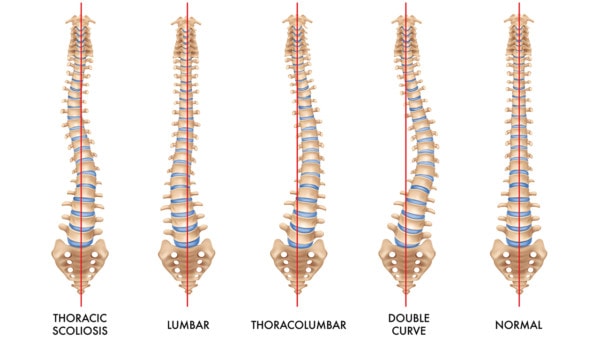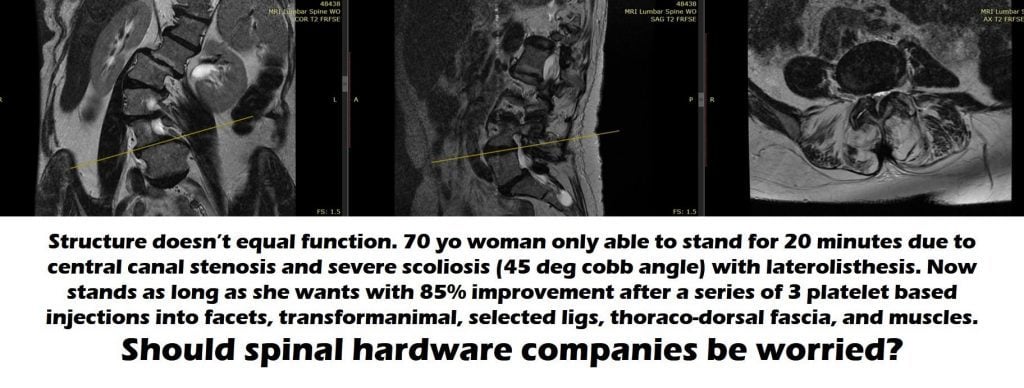Is Scoliosis Surgery Worth It?
Several years ago, one of our employees had severe scoliosis and was in severe pain. Given that this was a structural problem, I wasn’t sure we could help, but I developed a procedure called a percutaneous scolioplasty that did eventually make a difference. Let me review another patient today whose nonsurgical treatment results surprised me.
What Is Scoliosis?
Scoliosis is a side bend of the spine. The big problem is that the more the spine gets side bent, the more it wants to get out of whack. Why? Think of a tower of kid’s blocks. Once they get out of alignment, the likelihood that they will fall goes up. Gravity is the one constant.

Types of scoliosis. Macrovector/Shutterstock
Structure and Function
We are all taught that when the spine looks bad on MRI, this means that the abnormalities are causing pain. However, several research studies have taught physicians to take some of these findings with a grain of salt. Meaning that there are patients walking around out there with really abnormal spines who don’t have much pain, and then there are other patients who have more normal-looking spines who have pain. Still, when a spine has severe scoliosis and stenosis, as a physician, it’s hard to ignore.
Central canal stenosis is when the hole in the middle of the vertebrae (spine bones) gets smaller due to bone spurs and ligament swelling. Since the nerves that power the legs and transmit sensation travel through here, the legs can get weak or numb. This is usually worse with standing as this can cause the nerves to get pinched more than with sitting.
An Elderly Patient with Severe Scoliosis and Stenosis

Take a look at the MRI above on the left. You don’t need to be a doctor to know that viewed from the front, the spine should be straight and that this spine is anything but straight. In fact, it’s shaped like an “S” with one vertebra sliding off the other to the right in the image. It’s a mess. Add in the image to the far right that shows severe stenosis and you have a patient who surely needs surgery. However, is there a nonsurgical solution?
Percutaneous Scolioplasty
A few years back, I had been managing the pain in one of our employees who had severe scoliosis with platelet growth factor (platelet lysate) epidurals. That worked well, but I would need to repeat these every few months to manage her pain. I started to wonder, what if I treated the ligaments that resist side bend of the spine (inter-transverse) and the thoracodorsal fascia that resists rotation (a side bent spine often rotates as well). After a few treatments like this, she had the best pain relief we had ever obtained. So how did this work?
The inter-transverse ligaments are on the side of the spine and go between the transverse processes (bones that project outward on the side of the spine). They control the side bend of the spine. Because they are located far out from the center of gravity, they can have a big impact on the front rotation of each vertebra.

Stihii/Shutterstock
The thoracodorsal fascia is the tough fascial covering of the muscles in the spine. It connects into the spinous process in the midline, so when the vertebra rotates, one side in the back part of the fascia must get longer. So if we wanted to resist that rotation, we would selectively inject specific orthobiologic agents into that part of the thoracodorsal fascia to cause it to tighten down.

Hence, the percutaneous scolioplasty procedure involves selectively injecting the ligaments that are resisting the further side bending and rotation of the spine. This patient also had central canal stenosis, so how was that addressed? See my video below on the Regenexx-DDD procedure focusing on stenosis to understand that procedure better:
A Patient with the Severe Scoliosis and Stenosis
If there ever was a one-two punch of problems and an MRI to match that required surgery, this was the patient. The images above are awful. So when she was first seen and wanting to be treated and told me that she could only stand a few minutes at a time, I spent a good deal of our time together reducing expectations. I just didn’t know if what these two procedures (perc-scolioplasty and DDD) could do was enough in this kind of clinical scenario. However, given that her only other option was a major surgical fusion and decompression, I agreed to try.
I performed several procedures focusing on the above ligaments, fascia, muscles, joints, and nerves. These were intense 80- to 90-minute injection sessions using a combination of X-ray and ultrasound guidance. We use only platelet-based therapies, including high-dose PRP and platelet lysate. What was the result? She can now stand as long as she wants, which was our main outcome target. She’s also more active. Her pain is dramatically reduced, but she still hurts from time to time.
The upshot? I am very impressed with these procedures. If you had asked me five years ago if we could treat a patient like this without surgery, I would have laughed. However, it just goes to show you, there is always a better mousetrap.

If you have questions or comments about this blog post, please email us at [email protected]
NOTE: This blog post provides general information to help the reader better understand regenerative medicine, musculoskeletal health, and related subjects. All content provided in this blog, website, or any linked materials, including text, graphics, images, patient profiles, outcomes, and information, are not intended and should not be considered or used as a substitute for medical advice, diagnosis, or treatment. Please always consult with a professional and certified healthcare provider to discuss if a treatment is right for you.
